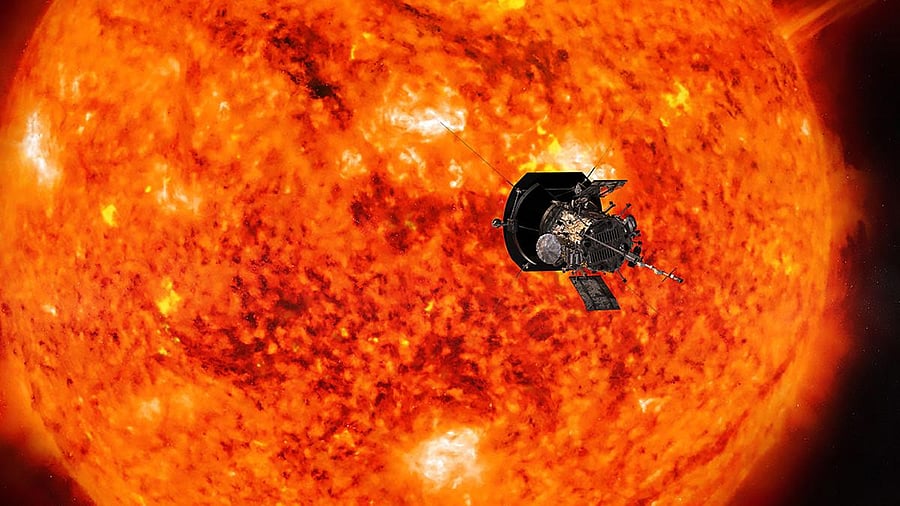
Mythology tells us that Hanuman, the monkey god, possessed the ability to fly at will. He is credited with cosmic travel as well! Once, as a child, presuming the rising sun to be a luscious fruit, he leapt into the sky, desiring to eat it — his audacious journey well-aided by the wind god, Vayu.
Nasa’s recently launched Parker Solar Probe (PSP) is on an equally daring attempt to reach the sun. The spacecraft will not just visit our parent star but will fly close to the outer fringes — the Corona. This historic mission will study the strange phenomena of solar winds that take place there, give us new insights into space weather conditions, the evolution of stars and help us understand the Sun-Earth connection better.
By November, PSP will be in the sun’s vicinity, and after that it will inch closer to the ball of gas and fire with every revolution it makes. In this odyssey, PSP has a few tricks up its sleeve, such as a unique heat shield to defend itself from the brutal heat and radiation spewing out from the raging star.
Our parent star, the sun, is a roiling, fuming mass of gas, radiating heat and light from the fusion of molecules. Despite its prominence in the sky and as the primary life-sustaining source on earth, very little is known about its evolution. The sun’s strange behaviour at its corona has baffled scientists since long. The impulsive and unpredictable nature of the Corona defies the fundamental laws of physics and has left astronomers speculating about what could be happening in its innards.
PSP will investigate all of this from close quarters: a mere six million kilometres away, while orbiting right through the solar atmosphere. PSP may lack Hanuman’s magical powers to gain momentum to traverse the enormous distance. Still, it will be travelling at peak speeds of 430,000 mph or 200 km per second — many times faster than any earlier spacecraft. At this velocity, Bengaluru to Mysore can be covered in half a second!
To gain the required momentum, PSP will make use of seven gravity assists of Venus to slingshot itself to reach the breakneck speed. To resist the sun’s gravity-well (the pulling force of a massive mass on a small object to collapse into it), PSP will take a heliocentric trajectory to make 24 orbits in seven years before plunging into the ball of fire. During these spins, the probe will make radial scans of the sun and observe the changes that happen, recording valuable data for its makers.
The inferno
At its core, the sun’s gravity produces enormous kinetic energy, giving rise to temperatures of several million degrees, reducing to a few thousand degrees at the surface and again rising enormously at the corona, where PSP will face 500 times more radiation.
So, how will PSP shield itself? The answer lies in understanding the difference between temperature and heat. Temperature is the measure of kinetic energy or vibrational energy of molecules in a system, whereas heat is the measure of how much energy is transferred by those molecules.
Since space is mostly empty, there are only a few particles available to transfer the thermal energy to the spacecraft. At its position, PSP will face temperatures of around 1,400 degrees Celsius. However, this temperature is hellish, too, and necessitates a protective shield for the probe.
The armour
“Though the idea of a solar probe originated as far back as 1958, it took technology six decades to catch up with those dreams,” said Nicola Fox, Project Scientist. It took thirty years of study for scientists at the John Hopkins Applied Physics laboratory (JHAPL) to design the solar probe’s Thermal Protection System (TPS) or heat shield.
The heat shield is indeed a thermal engineering marvel: it is an 11-cm thick, 3-metre wide irregular disc made of carbon foam. Thin graphite composite sheets are bonded to the top and bottom ends and, on annealing, it forms pure carbon. The foam core is porous to make it lightweight. Six custom-welded trusses (binders) fasten the TPS to the probe to further minimise heat conduction and are angled in such a way as to cast a shadow on the spacecraft platform.
The sunward side of the panels is sprayed with a specially formulated white ceramic coating to reflect most of the incident solar illumination back into space. At its closest point, the outer discs will face 1,400 degrees Celsius. Moreover, special reflectors will deflect most of the heat, keeping the measuring devices at a cool 30 degrees.
In a video demonstration, Betsy Congdon, the lead engineer of the heat shield at JHAPL, shows the heat protection of TPS using a blowtorch: as one end gets heated to glowing, red-hot condition, the opposite face remains cool to the touch.
As we read this, PSP is racing towards the sun and will soon begin its progressively shrinking circumambulations. The information from this pathbreaking mission will play a critical role in gathering information to safeguard our power grids, satellites and space travellers.